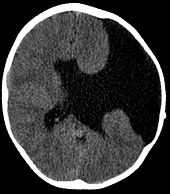Schizencephaly
| Schizencephaly | |
|---|---|
| Classification and external resources | |
 Axial CT scan showing schizencephaly in a 6-year old child | |
| ICD-10 | Q04.6 |
| ICD-9 | 742.4 |
| OMIM | 269160 |
| DiseasesDB | 33031 |
| eMedicine | radio/622 |
| MeSH | D054220 |
Schizencephaly (from Greek skhizein, meaning "to split", and enkephalos, meaning "brain")[1][2] is a rare birth defect characterized by abnormal continuity of grey matter extending from the ependyma of the cerebral ventricles to the pia mater. Type I schizencephaly has a cord of grey matter tissue, either with no fluid cleft or with ventricular or cortical lips closing one end of an abnormal fluid cleft through the hemisphere. Type II schizencephaly shows a cerebrospinal fluid-filled cleft of varying size and shape extending through the hemisphere from the ependyma centrally to the pia peripherally.
Presentation
Schizencephaly can be distinguished from porencephaly by the fact that in schizencephaly the fluid-filled component, if present, is entirely lined by heterotopic grey matter while a porencephalic cyst is lined mostly by white matter. Individuals with clefts in both hemispheres, or bilateral clefts, are often developmentally delayed and have delayed speech and language skills and corticospinal dysfunction. Individuals with smaller, unilateral clefts (clefts in one hemisphere) may be weak or paralyzed on one side of the body and may have average or near-average intelligence. Patients with schizencephaly may also have varying degrees of microcephaly, mental retardation, hemiparesis (weakness or paralysis affecting one side of the body), or quadriparesis (weakness or paralysis affecting all four extremities), and may have reduced muscle tone (hypotonia). Most patients have seizures, and some may have hydrocephalus.[3]
Causes
In schizencephaly, the neurons border the edge of the cleft, implying a very early disruption of the usual grey matter migration during embryogenesis. The cause of the disruption is not known, but likely the cause may be either genetic or a physical insult, such as infection, infarction, hemorrhage, in utero stroke, exposure to a toxin, or mutation. It is thought that normal neuron migration during the second trimester of intrauterine development, when primitive neuron pre-cursors (germinal matrix) migrate from just beneath the ventricular ependyma to the peripheral hemispheres where they form the cortical grey matter.
There was once thought to be a genetic association with the EMX2 gene, although this theory has recently lost support.[4] Causes of schizencephaly may be caused by environmental exposures during pregnancy sickness during pregnancy (such as Cytomegalovirus), exposure to toxins, or a vascular insult. Often there are additional associated heterotopias (isolated islands of neurons) which indicate a failure of migration of the neurons to their final position in the brain caused by possible stroke
Treatment
Treatment for individuals with schizencephaly generally consists of physical therapy (KG-ZNS with Vojta Methode), occupational therapy (with specific emphasis on neuro-developmental therapy techniques), treatment for seizures,[3] and, in cases that are complicated by hydrocephalus, a shunt.
www.wearerare.org is a non profit established to assist families facing this disorder.
Prognosis
The prognosis for individuals with schizencephaly varies depending on the size of the clefts and the degree of neurological deficit.[3]
Frequency and inheritance
There is no evidence of genetics being a cause..[citation needed]
References
- ↑ "schizo–". The New Oxford American Dictionary (2nd ed.).
- ↑ "encephalic". The New Oxford American Dictionary (2nd ed.).
- ↑ 3.0 3.1 3.2 "NINDS Schizencephaly Information Page". National Institute of Neurological Disorders and Stroke. NIH. Retrieved 2013-09-11.
- ↑ Tietjen, I.; Bodell, A.; Apse, K.; Mendonza, A. M.; Chang, B. S.; Shaw, G. M.; Barkovich, A. J.; Lammer, E. J.; Walsh, C. A. : Comprehensive EMX2 genotyping of a large schizencephaly case series. Am. J. Med. Genet. 143A: 1313-1316, 2007.
External links
- Schizencephaly at NINDS
- OMIM entries on Familial Schizencephaly, SIX3-Related
- WeAreR.A.R.E, Inc. Is a non-profit organization created to assist families with children who have Schizencephaly or rare brain disorders.
| |||||||||||||||||||||||